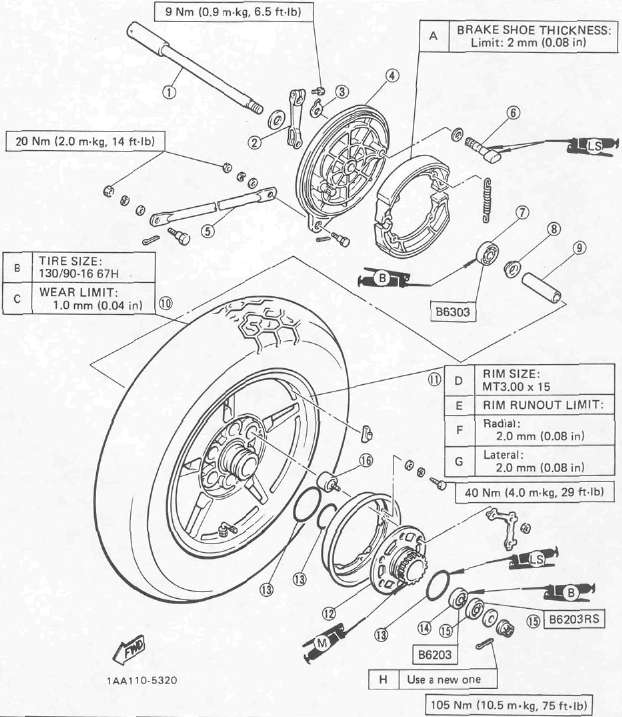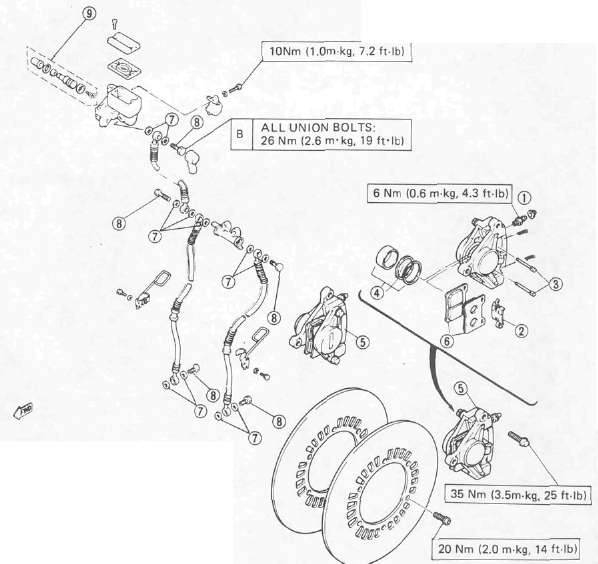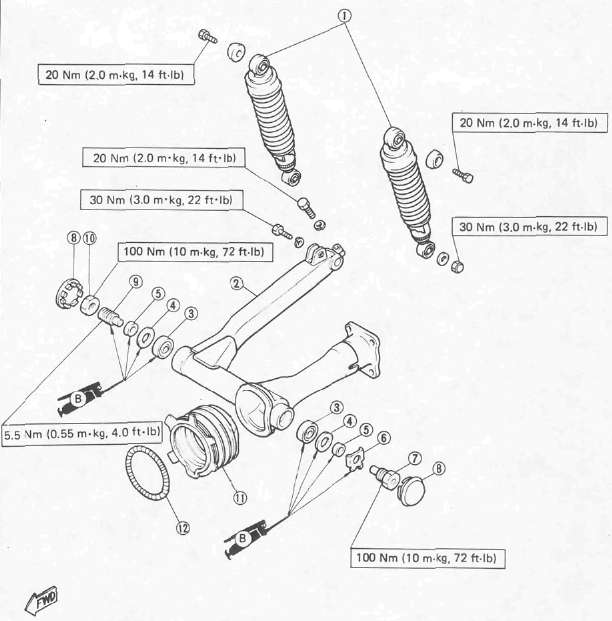Chapter 6, CHASSIS
Chapter 6, CHASSISFront Wheel
Front Wheel

FRONT WHEEL
1 Wheel axle
2 Collar
3 Oil seal
4 Bearing
5 Spacer
6 Speedometer gear unit
7 Tire
|
Basic weight: With oil |
232 kg (511 lb) |
|
|
Maximum load*: |
238 kg (525 lb) |
|
|
Cold tire pressure: |
Front |
Rear |
|
Up to 90 kg |
177 kPa |
196 kPa |
|
90 kg (198 lb) load- |
196 kPa |
275 kPa |
|
High speed riding |
206 kPa |
226 kPa |
*Load is the total weight of cargo, rider, passenger, and accessories.
TIRE SIZE: 100/90-19 57H
WEAR LIMIT: 1.0 mm (0.04 in)
RIM SIZE: MT2.15x 19
RIM RUNOUT LIMIT:
Radial: 2.0 mm (0.08 in)
Lateral: 2.0 mm (0.08 in)
REMOVAL
CAUTION:
Make sure the motorcycle is properly supported.
1. Place the motorcycle on its centerstand and a garage jack under the engine.

2. Remove:
• Speedometer cable
• Fork brace 1
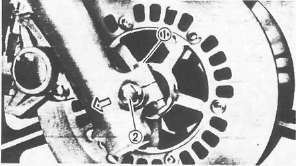
3. Loosen:
• Pinch bolt 1
4. Remove axle 2
NOTE:
Do not depress the brake lever when the wheel is off the motorcycle otherwise the brake pads will be forced shut.
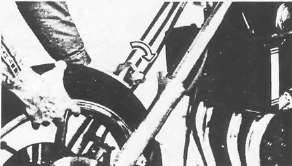
5. Remove front wheel
NOTE:
Lower the wheel until the discs come off the calipers. Turn the calipers outward so they do not obstruct the wheel.
INSPECTION
1. Inspect tire
Tire tread shows crosswise lines ("wear bars") or cracks.
Minimum Tire Tread Depth 1.0 mm (0.04 in)

1 Tread depth
2 Sidewall
3 Wear indicator
2. Inspect:
• Front axle
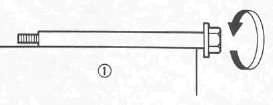
Roll the axle on a flat surface 1. Replace if it is bent.
WARNING:
Do not attempt to straighten a bent axle.
3. Inspect the front wheel. Replace if cracked, bent or warped.
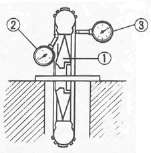
4. Measure the wheel 1 runout
Replace wheel or check bearings if runout exceeds specifications.
Rim Run-Out Limits:
Radial 2 : 2 mm (0.08 in) Lateral 3 : 2 mm (0.08 in)
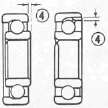
4 Bearing play

5. Check wheel balance.
Wheel is not statically balanced if it comes to rest at the same point after several light rotations.
Install appropriate balance weight at lightest point (on top).
NOTE:
Balance wheel with brake disc installed.
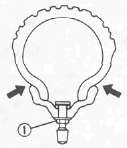
WARNING:
•After mounting a tire, ride conservatively to allow proper tire to rim seating. Failure to do so may cause an accident resulting in motorcycle damage and possible operator injury.
•After a tire repair or replacement, be sure to torque tighten the valve stem locknut 1 to specification.
Valve-Stem Locknut: 1.5 Nm (0.15 m-kg, 1.1 ft-lb)
WHEEL BEARING REPLACEMENT
1. Inspect wheel bearings
Wheel hub play/wheel turns roughly -> Replace.
Wheel bearing replacement steps:
• Clean wheel hub exterior.
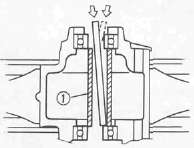
• Drive bearing out by pushing spacer aside and tapping around perimeter of bearing inner race. Use soft metal drift punch and hammer. The spacer 1 "floats" between bearings. Remove both bearings as described.
WARNING:
Eye protection is recommended when using striking tools.

• To install the wheel bearing, reverse the above sequence. Use a socket or bearing press 2 that matches outside diameter of bearing outer race to drive in bearing.
CAUTION:
Do not strike the center race or balls of bearing. Contact should be made only with the outer race.
INSTALLATION
1. Install Front wheel. Reverse removal procedure.
Note the following installation points:
• Lightly grease the front wheel oil seal lips and the gear teeth of the speedometer drive and driven gears. (Use lightweight, lithium base grease.)

• Be sure that the two projections 1 inside the wheel hub mesh with the two slots in the speedometer clutch assembly.
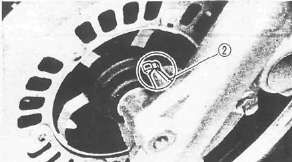
• Be sure that the projecing portion 2 (torque stopper) or the speedometer housing is positioned correctly.
• Compress the front forks serveral times to confirm proper fork operation before tightening the pinch bolt.
•Tighten the axle.
Axle: 105 Nm (10.5 m-kg, 75 ft-lb)
•Tighten the axle pinch bolt.
Axle Pinch Bolt: 20 Nm (2.0 m-kg, 14 ft-lb)
Rear Wheel and Brake
Rear Wheel and BrakeREAR WHEEL
1 Axle
2 Rear brake camshaft lever
3 Wear indicator
4 Brake plate
5 Tension bar
6 Rear brake camshaft
7 Bearing
8 Spacer flange
9 Spacer
10 Tire
11 Wheel
12 Clutch hub
13 O-ring
14 Bearing
15 Bearing
16 Damper
REMOVAL
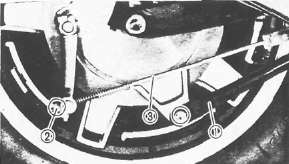
1. Place the motorcycle on its centerstand.
2. Remove:
• Cotter pin
• Axle nut
•Tension bar 1
• Brake rod adjuster 2
• Brake rod 3
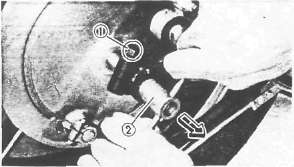
3. Loosen:
• Rear axle pinch bolt 1
4. Remove:
• Rear axle 2
• Rear wheel
Move the wheel towards the right side to separate it from final gear case.
INSPECTION
Brake Shoe
1. Measure the thickness of the brake shoes. Use slide calipers.
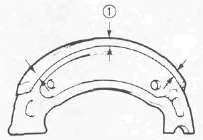
1 Measuring point
Brake Shoe Thickness: 4 mm (0.16 in)
Replacement Limit: 2 mm (0.08 in)
2. Inspect brake shoes. Sand glazed pads with coarse sandpaper.
Brake Drum
1. Inspect brake drum inner surface.
Wipe any oil off brake drum with rag soaked in lacquer thinner, brake parts cleaner or other solvent. Polish any scratches from brake drum lightly and evenly with emery cloth.
Brake Shoe Plate
1. Remove camshaft
2. Inspect cam face. Replace if worn. Grease camshaft before reassembly.
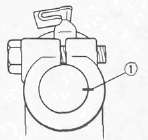
NOTE: .
Place alignment marks 1 on the cam lever and camshaft when assembly.
Rear Axle, Wheel and Wheel Bearing Replacement
Refer to "Front Wheel Inspection".
INSTALLATION
1. Install rear wheel -- Reverse removal steps.
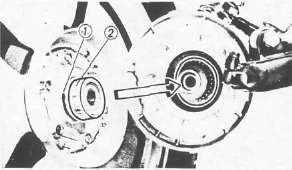
Rear wheel installation points:
• Lightly grease O-ring 1 and hub splines 2.
• Install wheel assembly and axle.
Axle Nut: 105 Nm (10.5 m-kg, 75 ft-lb)
Axle Pinch Bolt: 20 Nm (2.0 m-kg, 14 ft-lb)
Always use a new cotter pin on the axle nut.
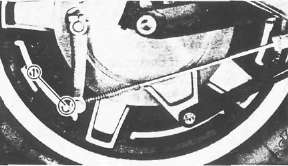
2. Adjust rear brake free play. Turn adjuster 1 as needed.
|
Adjuster |
Rear Brake Free Play |
|
Turn clockwise |
to reduce |
|
Turn counterclockwise |
to increase |
3. Adjust rear brake light switch
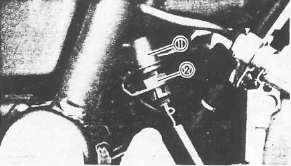
1 Switch body 2 Adjusting nut
Front Brake
Front BrakeFRONT BRAKE
1 Blead screw
2 Pad spring
3 Pad retaining pin
4 Caliper piston assembly (Replace as a set)
5 Caliper
6 Brake pads (Replace as a set)
7 Copper washer
8 Union bolt
9 Master cylinder kit {Replace as a set)
PAD SPRING

* Install the pad spring with its longer tangs facing upwards.
PAD THICKNES: Std.: 5.5 mm (0.22 in)
WEAR LIMIT: 0.5 mm (0.02 in)
BRAKE FLUID TYPE: DOT =3
CAUTION: Disc brake components rarely require disassembly. Do not:
• Disassemble components unless absolutely necessary.
• Use solvents on internal brake component.
• Use contaminated brake fluid for cleaning. Use only clean brake fluid.
• Allow brake fluid to come in contact with the eyes otherwise eye injury may occur.
• Allow brake fluid to contact painted surfaces or plastic parts otherwise damage may occur.
• Disconnect any hydraulic connection otherwise the entire system must be disassembled, drained, cleaned, and then properly filled and bled after reassembly.
BRAKE PAD REPLACEMENT
It is not necessary to disassemble brake caliper and brake hose to replace brake pads.
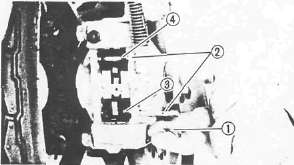
1. Remove:
• Cover
• Circlips 1
• Pad retaining pins 2
• Pad spring 3
• Pads 4

2. Install pads. Reverse removal steps.
NOTE:
• Install the pad spring with its longer tangs facing upwards.
• Replace pads as a set if either is found to be worn to the wear limit.
CALIPER DISASSEMBLY

1. Remove:
• Brake hose 1
• Caliper securing bolts 2
• Brake pads
2. Remove caliper piston assembly. Use compressed air and proceed carefully.
Caliper piston removal steps:
• Using a rag, lock the right side piston.
• Blow compressed air into the hose joint opening to force out the left side piston from the caliper body.
• Remove the dust and piston seals and reinstall the piston.
• Repeat previous step to force out the right side piston from the caliper body.

DO NOT LOOSEN "A"
• Cover piston with rag and use extreme caution when expelling piston from cylinder.
• Never attempt to pry out piston.
MASTER CYLINDER DISASSEMBLY
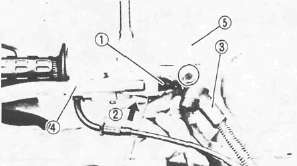
1. Remove:
• Brake light switch 1 Push 2 the brake light switch stopper.
• Brake hose 3
• Brake lever 4 and spring
• Master cylinder assembly 5
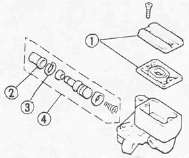
2. Remove:
• Cap 1 Drain remaining fluid.
• Master cylinder dust boot 2
• Circlip 3
• Master cylinder cup assembly
NOTE:
Be sure to reinstall the larger diameter lips of the cylinder cups first.
4 Master Cylinder Kit
INSPECTION AND REPAIR
|
Recommended Brake Component Replacement Schedule |
|
|
Brake pads |
As required |
|
Piston seal, dust seal |
Every 2 years |
|
Brake hoses |
Every 4 years |
|
Brake fluid |
Replace only when brakes disassembled |

1. Inspect the caliper piston assembly. Replace if there are scratches or other damage. Replace the brake pads as a set if worn below wear limits 1.
Brake Pad Wear Limit: 0.5 mm (0.02 in)
2 Wear indicator
2. Inspect master cylinder body and caliper body. Replace if scratched. Clean all passages with new brake fluid. Replace brake hoses if cracked, frayed, damaged or over 4 years old.
NOTE:
See Stainless Steel Brake Line Guide for dimensions.

3. Measure:
• Deflection 1
• Thickness 2
Turn or replace rotors if out of specification.
Maximum Deflection: 0.15 mm (0.006 in)
Minimum Disc Thickness: 4.5 mm (0.177 in)
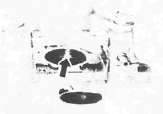
ASSEMBLY
Caliper
NOTE:
• All internal parts should be cleaned in new brake fluid only.
• Internal parts should be lubricated with brake fluid when installed.
• Replace the piston and dust seals whenever the caliper is disassembled.
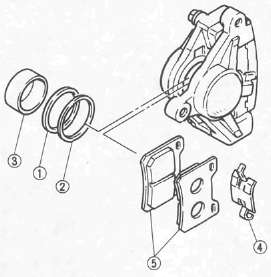
1. Install:
• Piston seal 1
• Dust seal 2
• Piston 3
• Pad spring 4
• Brake pads 5
• Caliper assembly

2. Tighten the caliper securing bolts 1 and brake hose union bolt 2
Caliper: 35 Nm (3.5 m-kg, 25ft-lb)
Brake Hose: 26 Nm (2.6 m-kg, 19 ft-lb)
3. Bleed the air completely.
Master Cylinder
1. Assemble the master cylinder

Union Bolt 1 : 26 Nm (2.6m-kg, 19 ft-lb)
Master Cylinder Holding Bolt 2 : 10Nm(1.0m-kg, 7.2ft-lb)
3 Copper washer 4 Master cylinder kit
2. Bleed the air completely.
AIR BLEEDING
Bleed the brake system if:
• The system has been disassembled.
• A brake hose has been loosened or removed.
• The brake fluid is very low.
• The brake operation is faulty.
WARNING:
A dangerous loss of braking performance may occur if the brake system is not properly bled.

Air bleeding steps:
a. Add proper brake fluid to the reservoir.
b. Install diaphragm.
Be careful not to spill any fluid or allow the reservoir to overflow.
c. Connect the clear plastic tube 1 (4.5 mm, 3/16 in inside dia.) tightly to the caliper bleed screw 2.
d. Place the other end of the tube into a container.
e. Slowly apply the brake lever several times.
f. Pull the lever in. Hold the lever in position.
g. Loosen the bleed screw and allow the lever to travel towards its limit.
h. Tighten the bleed screw when the leverlimit has been reached; then release the lever.
i. Repeat steps e to h until all of the air bubbles have been removed from the system.
NOTE:
If bleeding is difficult, it may be necessary to let the brake fluid system stabilize for a few hours. Repeat the bleeding procedure when the tiny bubbles in system have disappeared.
HAP'S Stainless Steel BRAKE LINE GUIDE
HAP'S Stainless Steel BRAKE LINE GUIDEApplies to
1985/86 Yamaha XJ700X / XJ750X Maxim-X
1985/86 Yamaha XJ700 Maxim
----- 3-PART BRAKE LINE GUIDE ------
|
Upper Brake Line |
Quantity |
1 |
|
|
Length 1 |
43.0cm (16.9in) |
||
|
Upper Fitting 2 |
Type #3 - 10mm / 15° |
||
|
Lower Fitting 2 |
Type #1 - 10mm / straight |
||
|
Orientation 3 |
Type C - 90° Rotation |
||
|
Lower Brake Line |
Quantity |
2 |
|
|
Length 1 |
55.5cm (21.9in) |
||
|
Upper Fitting 2 |
Type #3 - 10mm / 15° |
||
|
Lower Fitting 2 |
Type #1 - 10mm / straight |
||
|
Orientation 3 |
Type C - 90° Rotation |
||
|
Additional Features |
Shielding 4 |
Chrome Coil Spring |
|
|
Mid-Line Mounts 5 |
Rubber Bushings (Lowers) |
||
|
Fitting Boot 6 |
At Master Cylinder Only |
1 Length is measured to the full limits of each brake line, including both fittings
2 Fitting types are according to Rennsport's Fitting Identification Guide
3 Brake line fitting relative orientations are according to Rennsport's Fitting Orientation Guide
4 Available on factory brake lines only
5 Bushings are removable for use on after-market brake lines
6 No longer available for replacement so don't lose or damage boot
Front Fork
Front ForkFRONT FORK
1 Cap bolt
2 O-ring
3 Spacer
4 Spring seat
5 Fork spring
6 Damper rod
7 Inner fork tube
8 Slide bushing
9 Taper spindle
10 Dust seal cover
11 Dust seal
12 Circlip
13 Fork seal
14 Washer
15 Guide bushing
16 Outer fork tube
17 Damper rod securing bolt
FORK OIL: Capacity (Each leg): 389 cm3 (13.7 Imp. oz, 13.2 US oz)
Type: YAMAHA FORK & SHOCK OIL 10Wt or equivalent fork oil
SPRING FREE LENGTH LIMIT: 505 mm (19.9 in)
AIR PRESSURE
Standard: 39.2 kPa (0.4 kq/cm\ 5.7 psi)
Maximum: 118 kPa (1.2 kg/cm2, 17 psi)
Minimum: Zero

REMOVAL AND DISASSEMBLY
Support the motorcycle securely so there is no danger of it falling over.

1. Remove the air valve cap 1
NOTE:
Keep the valve 2 open by pressing it for several seconds so that the air can be let out of the inner tube.
2. Loosen:
• Inner tube pinch bolt 3
• Cap bolt 4
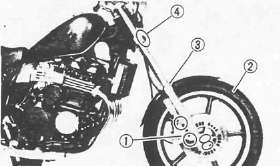
3. Remove:
• Brake caliper 1
• Front wheel 2
• Fork brace 3
4. Loosen:
• Lower front fork pinch bolts 4
CAUTION:
Support the fork before loosening the pinch bolts.
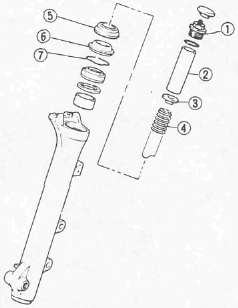
5. Remove:
• Front fork assembly (from the under bracket)
• Cap bolt 1
• Spacer 2
• Spring seat 3
• Fork spring 4
• Dust seal cover 5
• Dust seal 6
• Circlip 7
6. Fill the fork inner tube with fork oil. Stretch the inner tube before filling.
7. Install the Cap bolt 1
8. Remove oil seal from outer tube. Press the inner tube to facilitate removal.
CAUTION:
• If air enters the inner tube or it is compressed abruptly oil may spurt out or the coil seal may be ejected.
• Never touch the inner tube during a disassembly operation.
• Be sure to wrap the oil seal with a rag for safety.
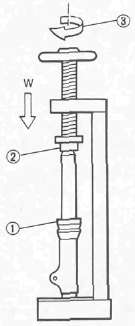
1 Wrap with rag
2 Socket wrench (suitable socket)
3 Turn slowly
9 Remove:
• Oil seal
• Washer
• Cap bolt
• Fork spring
10. Drain the oil from the fork.

11. Remove the damper rod securing bolt. Use T-handle (90890-01326) 1 and Damper Rod Holder (90890-01365) 2 to remove the damper rod. The holder can be fabricated by securing double nuts requireing a 19mm socket to a bolt or length of threaded rod. These will fit into the 19mm hex in the base of the fork and can then be held with a socket and long extension.

12. Remove:
• Damper rod
• Damper rod spring
• Inner fork tube
• Guide bushing (from outer tube)
• Slide bushing
• Taper spindle
1 Pull inner tube from outer tube.
INSPECTION
1. Inspect the inner fork tube. Replace if severe scratches, bends or a damaged oil lock valve are found.
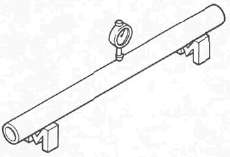
Do not attempt to straighten a bent fork tube as this may dangerously weaken the tube,
2. Inspect the outer fork tube. Replace if bent or if fork seal seat is damaged.
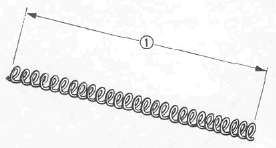
3. Measure the spring free length 1. Replace if less than limit.
Fork Spring Free Length Limit: 505 mm (19.9 in)
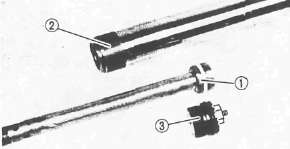
4. Inspect the damper rod. Replace seal and/or slide bushing if worn. Replace Cap bolt o-ring if damaged. Wash and blow out all passages.
ASSEMBLY
NOTE:
• Be sure all components are clean before assembly.
• Always install the new oil seal, bushings, and the dust seal. Do not reuse them.
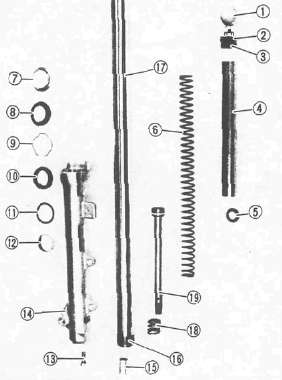
1 Cap
2 O-ring
3 Cap bolt
4 Spacer
5 Spring seat
6 Fork spring
7 Dust seal cover
8) Dust seal
9 Circlip
10 Fork oil seal
11 Washer
12 Guide bushing
13 Damper rod securing bolt
14 Outer fork tube
15 Taper spindle
16 Slide bushing
17 Inner fork tube
18 Damper rod spring
19 Damper rod
1. Install:
• Damper rod spring
• Damper rod. Allow rod to slide slowly down the inner fork tube until it protrudes from the bottom.
• Taper spindle
• Inner fork tube
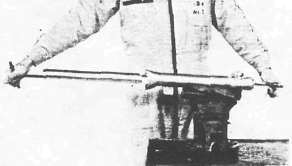
2. Install damper rod securing bolt. Hold damper rod with Damper Rod Holder (90890-01365) and T-handle (90890-01326).
Damper Rod Securing Bolt:
30 Nm (3.0 m-kg, 22 ft-lb) LOCTITE® Stud N'Bearing Mount (red)

3. Install the guide bushing 1 Press guide bushing into the outer fork tube with Fork Seal Driver (90890-01367) 2 and Adapter (90890-01372)3. A substitute can be fabricated from 1 1/2" ABS drain pipe.

4. Install:
• Washer 1
• New fork oil seal 2. Press fork oil seal into the outer fork tube with Fork Seal Driver (90890-01367) 3 and Adapter (90890-01372) 4.

5. Install:
• Circlip1
• Dust seal 2
• Dust seal cover 3
6. Fill:
• Front fork with fork oil.
Capacity: 389 cm3 (13.7 Imp. oz, 13.2 US oz)
Type: Yamaha Fork & Shock Oil 10Wt or equivalent fork oil
WARNING:
Ensure each fork is filled with the same amount of oil or bike may develop a deadly wobble at speed.
7. Install:
• Fork spring
• Spring seat
• Spacer
• Cap bolt (into the inner fork)
8. Install the front fork assembly into the under bracket.
9. Tighten:
• Lower front fork pinch bolts.
• Cap bolt
Cap Bolt: 23Nm(2.3m-kg, 17ft-lb)
10. Loosen Lower front fork pinch bolts
11. Install front fork into the steering crown.
NOTE:
Be sure the inner fork tube end is flush with the top of the steering crown.

12. Tighten:
• Front fork pinch bolt (Upper) 1
• Front fork pinch bolts (Lower) 2
Upper Pinch Bolt: 20 Nm (2.0 m-kg, 14 ft-lb)
Lower Pinch Bolts: 23Nm(2.3m-kg, 17ft-lb)
13. Continue assembly by reversing of Removal and Disassembly sequence. Install and torque tighten each component as specified.
Disc Brake Caliper: 35 Nm (3.5 m-kg, 25 ft-lb)
Front Wheel Axle: 105 Nm (10.5 m-kg, 75 ft-lb)
Wheel Axle Pinch Bolt: 20Nm(2.0m-kg, 14 ft-lb)

14. Fill front fork with air
Standard Air Pressure: 39.2 kPa (0.4 kg/cm2, 5.7 psi)
15. Install air valve cap
Steering Head
Steering HeadSTEERING HEAD
1 Handlebar bolt
2 Handlebar upper bracket
3 Steering crown
4 Special washer
5 Upper ring nut
6 Washer
7 Lower ring nut
8 Bear ing cover
9 Bearing
10 Fork brace
REMOVAL
1. Remove:
• Front wheel
• Front forks
2. Remove the headlight lens unit
3. Disconnect the wire connectors in the headlight shell.

4. Remove:
• Headlight shell securing bolt 1
• Brake hose joint securing bolts 2
• Headlight shell 3

5. Disconnect the meter panel wiring connectors

6. Remove:
• Covers
• Handlebar bolts 1
• Handlebar upper brackets 2
• Handlebar assembly 3
• Steering stem nut 4
• Steering crown and meter panel assembly

7. Remove the special washer 1
8. Loosen the upper and lower ring nuts. Use Steering Ring Nut Wrench (90890-01268) 2.

9. Remove:
• Upper ring nut
• Washer
• Lower ring nut 1
• Bearing cover 2
• Bearing 3
• Steering stem
INSPECTION

1. Check the bearings 1. Replace if pitted or otherwise damaged.
ASSEMBLY

1. Lubricate the bearings with Wheel Bearing Grease.
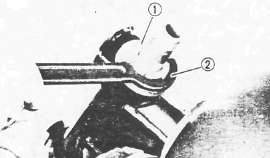
2. Install:
• Bearing (onto steering stem)
• Steering stem
• Bearing cover
• Lower ring nut 1
3. Tighten the lower ring nut 1. Use Steerinq Nut Wrench (90890-01268) 2.
Lower Ring Nut (Initial): 50 Nm (5.0 m-kg, 36 ft-lb)
4. Loosen the lower ring nut completely.
5. Retighten the ring nut to the final torque setting.
Lower Ring Nut (Final): 6Nm (0.6 m- kg, 4.3 ft- lb)
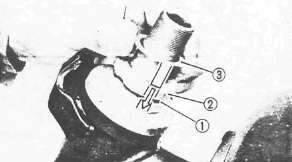
6. Install:
• Washer 1
• Upper ring nut 2
7. Finger tighten the upper ring nut 2
8. Install the special washer 3

9. Install:
• Steering crown and meter panel assembly
• Steering stem nut 1
10. Check the steering head operation. Turn it from lock to lock. Grasp the fork lowers and push/pull. Readjust if there is any looseness or binding.
11. Position the front fork into steering crown. This will facilitate alignment of under-bracket holes with steering crown holes.
12. Tighten the steering stem nut
Steering Stem Nut: 110Nm (11 m- kg, 80 ft- lb)
13. Continue assembly by reversing removal sequence.
Fork Pinch Bolt (Upper): 20 Nm (2.0 m-kg, 14 ft-lb)
Fork Pinch Bolt (Lower):23 Nm (2.3 m-kg, 17 fft-lb)
Brake Hose Joint: 9 Nm (0.9 m-kg, 6.5 ft-lb)
Fork Brace: 9Nm (0.9 m-kg, 6.5 ft-lb)
Caliper: 35 Nm (3.5 m-kg, 25 ft-lb)
Axle: 105 Nm (10.5 m-kg, 75 ft-lb)
Axle Pinch 8olt: 20 Nm (2.0 m-kg, 14 ft-lb)
14. Check the steering head operation. Turn it from lock to lock. Readjust tightness of steering stem if it is loose or binding.
Swingarm and Rear Shock Absorber
Swingarm and Rear Shock AbsorberSWINGARM AND REAR SHOCK ABSORBER
1 Rear shock absorber
2 Swingarm
3 Bearing
4 Oil seal
5 Collar
6 Lock washer
7 Left pivot shaft
8 Pivot cover
9 Right pivot shaft
10 Nut
11 Rubber boot
12 Spring band
SWINGARM FREE PLAY INSPECTION

1. Remove:
• Rear wheel
• Rear shock absorbers 1
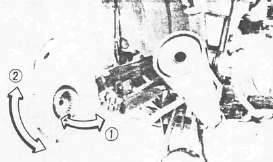
2. Check the swingarm side play 1. Grasp and move from side to side. Check and adjust bearing if there is any play. Rotate swingarm verticaly 2. Check and adjust bearings if there it is loose or binding. Replace if there are rough spots or other damage.
REMOVAL
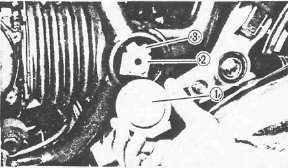
1. Remove:
• Rear wheel
• Rear shock absorbers
• Pivot covers 1
2. Flatten the lock washer tab on the left pivot shaft.
3. Remove:
• Left pivot shaft 2
• Lock washer 3

4. Remove:
• Right pivot shaft 1
• Locknut 2
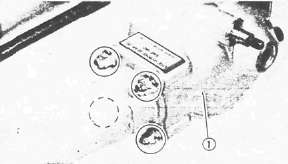
5. Remove:
• Swingarm assembly
• Final gear case assembly 1
INSPECTION AND LUBRICATION
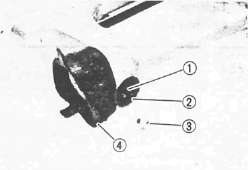
1. Inspect:
• Bearings 1
• Oil seals 2
• Collars 3
• Rubber boot 4
Replace any damaged components.
2. Lubricate the bearings and oil seal with Waterproof Wheel Bearing Grease
ASSEMBLY
1. Install:
• Swingarm assembly
• Lock washer
• Left pivot shaft
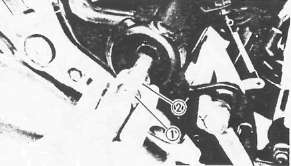
• Right pivot shaft 1
• Locknut 2

2. Tighten the left pivot shaft
Left Pivot Shaft: 100 Nm (10m-kg, 72ft-lb)
3. Bend lock washer tab.

4. Tighten the right pivot shaft 1
Right Pivot Shaft: 5.5 Nm (0.55 m-kg, 4.0 ft-lb)
5. Tighten the right pivot shaft locknut 2
Right Pivot Shaft Nut: 100 Nm (10 m-kg, 72 ft-lb)
6. Install the pivot cover
7. Continue assembly by reversing of removal sequence.
Final Gear Case Securing Nut: 42 Nm (4.2 m-kg, 30 ft-lb)
Shaft and Rear Drive
Shaft and Rear DriveSHAFT DRIVE
Refer to "CHAPTER 3". for the middle gear.
The following special tools are not available but can be constructed for the final gear disassembly and assembly:
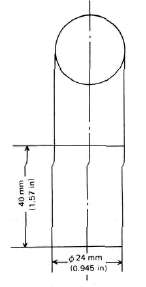
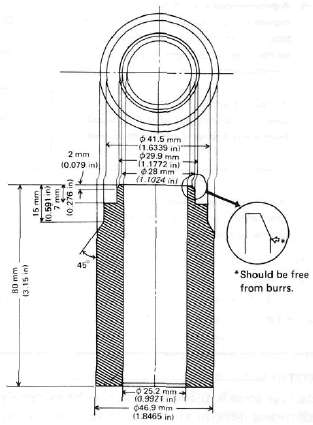
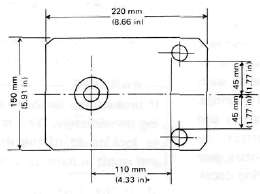
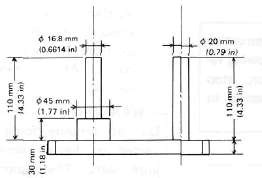
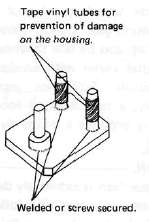
A. Troubleshooting
1. The following conditions may indicate damaged shaft drive components:
|
Symptoms |
Possible damaged areas |
|
1. A pronounced hesitation or "jerky" movement during acceleration, deceleration, or sustained speed. (This must not be confused with engine surging or transmission characteristics). 2. A "rolling rumble" noticeable at low speed; a high-pitched whine; a "clunk" from a shaft drive component or area. |
A. Damage to bearings. B. Improper gear lash. C. Gear tooth damage. D. Drive flange/universal joint bolts loose. |
|
3. A locked-up condition of the shaft drive mechanism; no power transmitted from engine to rear wheel. |
E. Broken drive-shaft. F. Disconnected flange/universal joint connection. G. Broken gear teeth. H. Seizure due to lack of lubrication. I. Small foreign object lodged between moving parts. |
Note:
Damage areas A, B, and C above may be extremely difficult to diagnose. The symptoms are quite subtle and difficult to distinguish from normal motorcycle operating noise. If there is reason to believe component(s) are damaged, remove component(s) for specific inspection.
2. Inspection Notes:
a. During coasting, accelerating or decelerating, the "rolling rumble" will increase with rear wheel speed, not engine or transmission gear speeds. However, such noise may also be due to wheel bearings.
b. Noise that varies with acceleration and deceleration: Following incorrect reassembly, a condition of too-little gear lash may produce a whine during deceleration.
CAUTION:
Too-little gear lash is extremely destructive to gear teeth. If a test ride following reassembly indicates this condition, stop riding immediately to minimize damage to gears.
c. A slight "thunk" must be distinguished from normal motorcycle operation. It will be most noticeable at low speed and could indicate broken gear teeth.
WARNING:
If broken gear teeth are suspected, stop riding immediately. This condition could lead to locking-up of the shaft drive assembly and result in harm to a rider.
d. If the drive flange/universal joint bolts are slightly loose, a "clunk" may be felt when slowly taking off, or when changing from slow acceleration to slow deceleration. At high speed this will result in vibration.
WARNING:
Do not continue riding a motorcycle suspected of having loose flange/universal joint bolts. The components may break, causing injury to a rider.
3. Troubleshooting Chart
Where Basic Conditions "a" and "b" above exist, consider the following Chart:
|
Elevate and spin front wheel. Feel for wheel bearing damage. |
Yes ► |
Replace wheel bearing. (See CHAPTER 5 "Front wheel") |
|
|
||
|
Check rear wheel. Feel for bearing damage. |
No ►
|
Rear wheel bearings and shaft drive bearings probably not damaged. Repeat test or remove individual components. |
|
|
||
|
Remove rear wheel. Check for wheel bearing damage. |
Yes ► |
Replace rear wheel bearing. (See "Rear Wheel" section in this chapter.) |
|
|
||
|
Remove drive shaft components. |
4. Oil Leak Inspection
If a shaft drive component is suspected of leaking oil, first thoroughly clean the entire motorcycle. The apparent location of an oil leak on a dusty motorcycle may be misleading. Dry the motorcycle and apply a leak-localizing compound or a dry-powder spray that will limit the flow of any leaking oil. Operate the motorcycle prepared in this way for the distance necessary to precisely locate the leak. There are the possibilities that a component housing may have been damaged by road debris or an accident, or a gasket or seal may be cracked or broken. However, on new or nearly new motorcycle an apparent oil leak may be the result of a rust-preventive coating or excess assembly lubrication of seals. Always clean the motorcycle and recheck the suspected location of any apparent leakage.

5. Checking Drained Oil
Whenever a problem is suspected in either the middle or final gear assemblies, drain and inspect the oil. Metal particles on the drain plug or in the oil could indicate a bearing seizure or other problem in the component. However, a small amount of metal particles in the oil is normal.
B. Final Gear Removal
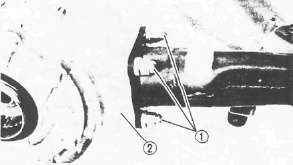
1. Remove:
• Rear axle
• Rear wheel (see "Rear Wheel" section in this chapter).
• Left shock absorber
• Nut 1
• Final gear assembly 2
2. Remove the 4 nuts holding the Final Drive unit to the swing arm.
3. Remove the final gear assembly.
C. Gear Lash Check and Adjustment
1. Secure the gear case in a vice or other support.
2. Remove one nut from the final gear case stud bolt. Install the gear holder (special tool) over the ring gear surface and stud bolt. Tighten the holder to stud bolt with a nut.
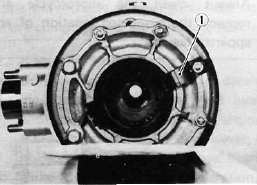
1. Final gear holding tool
3. Install the final gear lash measurement tool on the gear coupling.
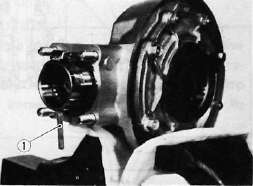
1. Gear lash measurement tool (Final gear)
4. Mount a dial gauge against the lash measurement tool at the scribed mark (60 mm, 2.36 in from the center of the shaft).
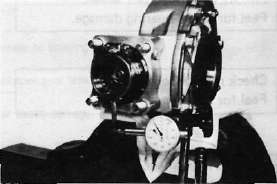
5. Use the special wrench to gently rotate the gear coupling back and forth. Note the lash measurement on the dial gauge.
Final gear lash:
When using the measurement tool: 0.25 - 0.50 mm (0.010-0.020 in) .
Actual gear lash on the final gear teeth: 0.1 ~ 0.2 mm (0.004 ~ 0.008 in).
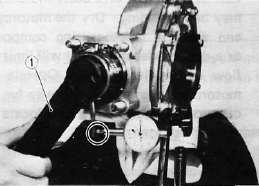
1. Middle and final gear holding tool
6. If the gear lash exceeds the specified limits, adjust as follows:
a. To reduce gear lash, increase the ring gear shim.
b. To increase gear lash, reduce ring gear shim.
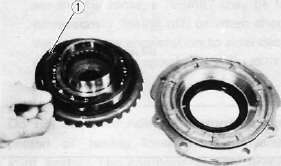
1. Ring gear shim
c. If it is necessary to increase the ring gear shim by more than 0.1 mm reduce the thrust washer thickness by 0.1 mm for each 0.1 mm of ring gear shim increase and if it is necessary to reduce shim by more than 0.1 mm, reverse above procedure.
D. Final Gear Disassembly
1. Remove the nuts and bolts holding the bearing housing.
2. Remove the ring gear assembly and thrust washer from the final gear case.
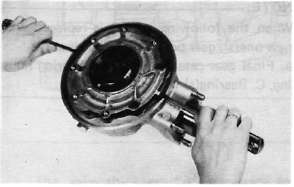
3. Remove the self-locking nut from drive pinion by using the holding tool (special tool) and remove the coupling.
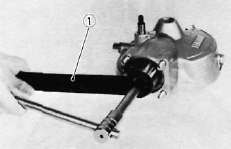
1. Middle and final gear holding tool
4. Remove the drive pinion bearing retainer with the retainer remover (special tool).
CAUTION:
The drive pinion bearing retainer nut is left hand threads. Turn the retainer nut clockwise to loosen.
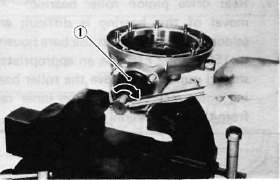
1. Drive pinion bearing retainer remover
5. Remove the drive pinion and bearing with the slide hammer and adapter (special tool).
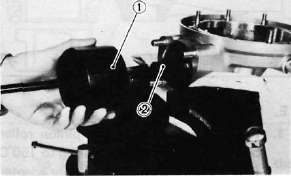
1. Slide hammer 2. Adapter
CAUTION:
This drive pinion removal should be performed only if gearing replacement is necessary. Do not re-use bearings or races after removal.
6. Remove the guide collar, oil seal, and roller bearing from the main housing by using the press tool No. 1 (special tool) and a press. Use an appropriate supports for the main housing during this operation. The roller bearing may be re-used if undamaged. Do not re-use oil seal.
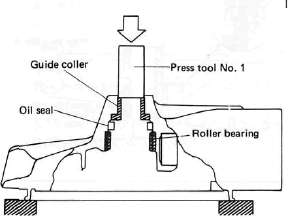
Rear drive pinion roller bearing; removal of this bearing is difficult and seldom necessary. Heat the bare housing to 150°C (302°F). Use an appropriately shaped punch to remove the roller bearing outer race. Remove the inner race from the drive pinion.
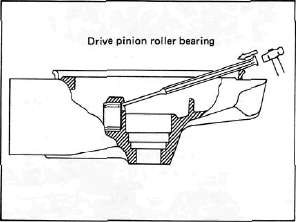
E. Final Gear Reassembly
1. Install the new rear drive pinion roller bearing. Heat the bare bearing to 150°C (302°F) and use an appropriately adapter to install the roller bearing outer race. Install the inner race onto the drive pinion.
2. Using the press tool No. 2 (special tool) and a press, install the guide collet, new oil seal, and roller bearing into the main housing in that order.
NOTE:
The removed roller bearing can be used if undamaged; however, we recommend replacement with a new one.
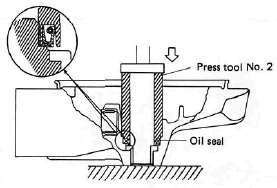

3. Final drive/ring gear positioning
NOTE:
When the following part(s) is replaced with new one(s), gear positioning is necessary: a. Final gear case, b. Ring gear bearing housing, C. Bearing(s)

a. The shim thickness "A" necessary for the drive pinion gear positioning can be calculated from the information found on the final gear case and on the drive gear end.

1. Size number

To fined shim thickness "A" use the
formula:
A = a -b
Where:
a = a numeral (usually a decimal number) on the gear near the tooth and either added to or detracted from the nominal size "84".
b = a numeral on the gear case appearing as a whole figure (ie. 83.50).
Example:
1) If the pinion gear is marked "+01"....."a" is 84.01.
2) If the gear case is marked "83.50".
A = 84.01 - 83.50 A = 0.51
Then the necessary shim thickness is 0.51mm.
Shim sizes are supplied in the following thicknesses:
0.15 mm, 0.30 mm, 0.40 mm, 0.50 mm, 0.60 mm.
Because the shims can only be selected in 0.05 mm increments the following chart should be used when encountering last digits that are not 5 or zero (0):
|
Last digits |
Rounding |
|
0,1,2 |
0 |
|
3, 4, 5, 6, 7 |
5 |
|
8,9 |
10 |
b. The shim thickness "B" necessary for the ring gear positioning can be calculated from the information found on the final gear case, ring gear, and bearing.
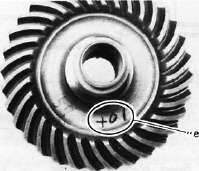
To find shim, thickness "B" use the
formula:
B = c + d-(e + f)
Where:
c= a numeral on the gear case appearing as a whole figure (ie. 45.52)
d = a numeral (usually a decimal number) on the outside of the ring gear bearing housing and added to the nominal size "3".
e= a numeral (usually a decimal number) on the inside of the ring gear and; either added to or detracted from the nominal size "35.40".
f = a bearing thickness (considered constant)
Distance "f" = 13.00 mm
Example:
1) If the gear case is marked "45.52".
2) If the ring gear bearing housing is marked "35"....."d" is 3.35.
3) If the ring gear is marked "+01" ..... "e" is 35.40 + 0.01 = 35.41.
4) "f" is 13.00.
B = c + d-(e + f)
B = 45.52 + 3.35 - (35.41 + 13.00)
B = 48.87- (48.41)
B = 0.46
Then the necessary shim thickness is
0.41 mm.
NOTE:
Use the chart for the drive pinion shim to select the ring gear shim size.
4. Install the drive pinion gear with the proper size of shim(s) and secure it with the bearing retainer nut with the drive pinion bearing retainer remover (special tool).
NOTE:
The bearing retainer nut is left hand threads; turn the nut to counterclockwise to tighten.
Tightening torque: 11 m-kg (80 ft-lb)
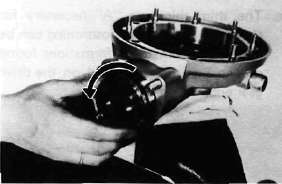
Install the ring gear assembly without the thrust washer. Adjust the gear lash (refer to "C. Gear lash check and adjustment).
Place four pieces of "PLASTIGAGE" between the originally fitted thrust washer and ring gear. Install the gear case onto the ring gear assembly and tighten the nuts and bolts with the specified torque.

Tightening torque;
Bolt/Nut......... 2.3 m-kg
(16.6 ft-lb)
NOTE:
Do not turn the drive pinion/ring gear when measuring clearance with "PLASTIGAGE".
8. Remove the ring gear assembly and determine the clearance by measuring the width of the flattened "PLASTIGAGE".

1. PLASTIGAGE
Ring gear thrust clearance. 0.1 ~ 0.2 mm
9. If the clearance exceeds the specification above, replace the thrust washer to obtain the proper clearance.
DRIVE SHAFT/JOINT

A. Removal
1. Remove the rear wheel. See "REAR WHEEL A. Removal" in this chapter.
2. Remove the final gear case assembly.
3. Remove the drive shaft. See "SWING ARM removal" in this chapter.
4. To remove the universal joint, it is necessary to remove the swing arm. Remove the universal joint assembly.
B, Inspection
1. Drive shaft
Inspect the shaft splines for wear and/or damage. If excessive, replace the drive shaft.
NOTE:
When installing the drive shaft, lubricate splines with molybdenum di-sulfide grease.

2. Universal joint
a. There should be no noticeable play in the universal joint bearings. If there is any play in the bearing, replace the universal joint assembly.
b. Move the universal joint up and down and from side to side. The universal joint should move smoothly. Without tightness, binding or rough spots that could indicate damaged bearings. If damaged, replace the universal joint assembly.
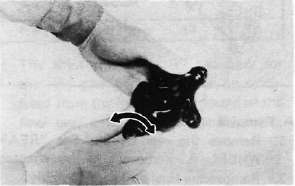
C. Reinstallation
When installing the drive shaft and the universal joint, reverse the removal procedure. Note the following points:
1. Lubricate the shaft splines with molybdenum di-sulfide grease.
2. Tighten the universal joint securing bolts and final gear case securing nuts with the specified torque:
Final gear case: 4.2 m-kg (30.4 ft-lb) Universal joint: 4.4 m-kg (31.8 ft-lb)
Cables and Maintenance
Cables and MaintenanceCABLE MAINTENANCE
NOTE:
See "Maintanance and Lubrication" intervals charts. Cable maintenance is primarily concerned with preventing deterioration and providing proper lubrication to allow the cable to move freely within its housing. Cable removal is straightforward and uncomplicated. Removal is not discussed within this section.
WARNING:
Cable routing is very important. For details of cable routing, see cable routing diagrams at end of this manual. Improperly routed or adjusted cables may make motorcycle operation unsafe.
1. Remove the cable
2. Inspect the cable for obstructed movement, kinking and/or frayed strands.Replace if damaged.
Cable Lubrication Steps:
• Hold the cable in a vertical position.
• Apply lubricant to the uppermost end of the cable.
• Leave in a vertical position until the lubricant appears at the bottom.
• Allow excess to drain, then reinstall the cable.
NOTE:
Choice of lubricant depends upon conditions and preferences; however, a semi-drying chain and cable lubricant will perform adequately under most conditions.
THROTTLE MAINTENANCE
1. Remove: the Phillips head screws from throttle housing assembly. Separate the housing halves.
2. Disconnect the cable from throttle grip assembly.
3. Remove the throttle grip assembly
4. Clean all parts with mild solvent.
5. Inspect:
• Contact surfaces
• Right-hand end of handlebar
Deburr or replace.
6. Lubricate all contact surfaces with a light coat of lithium-soap base grease and reassembly.
NOTE:
Tighten the housing screws evenly to maintain an even gap between housing halves.
